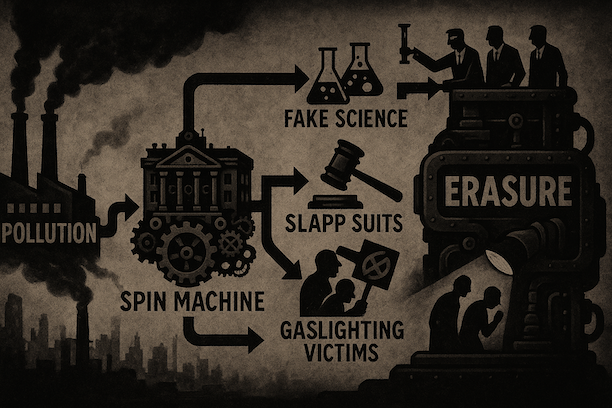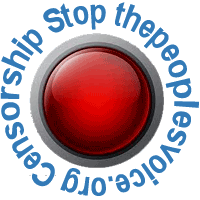| « Profits and Poison: The Pseudoscience Killing Millions | The Radical Wisdom of Neutrality » |
How PR Firms Delete the Evidence of Environmental Crimes—Then Blame the Victims
Robert David
Polluters don’t just dump toxins. They dump stories—engineered by billion-dollar PR firms.
They Poisoned the Planet—Then Hired Spin Doctors to Make You Forget
When a chemical spill poisons a town, when a pipeline ruptures in a fireball, when a refinery’s exhaust leads to childhood leukemia—the catastrophe is not accidental. It is logistical. The spill, the leak, the cancer cluster—these are the externalities of an engineered calculus where human life is expendable, but reputation is not.
Behind every ecological crime scene is a constellation of public relations firms, brand protection consultants, litigation deflectors, and "strategic communication specialists" whose task is not to repair the damage, but to erase it from memory. They do not merely manage the narrative—they construct a counter-narrative so aggressively curated that the victims themselves are often blamed, pathologized, or pathologized into silence.
This is The Corporate Erasure Machine—a metastasized apparatus of elite information control, built not to win debates but to bury causality. It is the reason DuPont could pollute an entire watershed with PFOA, lie to regulators, and then mount a media campaign implying the chemical was safer than table salt (Rich, 2016). It is the reason Chevron spent over $2 billion to surveil, harass, and ultimately jail a lawyer who held them accountable for their toxic legacy in the Ecuadorian Amazon (Lerner, 2020). And it is why, to this day, most Americans have never heard of the 40,000-plus documented “sacrifice zones” where pollution-related illness and premature death are normalized (Hedges & Sacco, 2012).
The Machine works in six coordinated domains:
- Suppression of scientific consensus
- Appropriation of reformist language
- Criminalization of whistleblowers
- Colonization of media and academia
- Gaslighting of victims and dissidents
- Government Agency Capture
These mechanisms are neither new nor theoretical. They are standard operating procedure, outlined in internal documents obtained via FOIA lawsuits, whistleblower testimony, and investigations by independent journalists.
To understand how this system functions is not merely an act of analysis—it is a form of resistance. Because what pollutes the body also pollutes the record. And until we expose those who launder toxicity into trust, no amount of cleanup will ever be enough.
1. Manufacture Doubt, Bury the Science
The first weapon in the corporate arsenal is manufacturing doubt—an established strategy designed to fracture scientific consensus and stall regulatory action. When the evidence linking pollution to illness becomes overwhelming, corporations do not debate; they obfuscate. They hire armies of so-called “independent” researchers, fund front groups, and manipulate peer review processes to seed confusion in the public mind.
ExxonMobil’s infamous internal research from the 1970s confirmed climate change was real and caused by fossil fuels (Supran & Oreskes, 2017). Yet for decades, Exxon funneled millions into climate denial networks, funding think tanks like the Competitive Enterprise Institute and Heartland Institute to discredit established science. This strategic denialism delayed policy responses and misled generations of the public (Brulle, 2014).
Similarly, chemical manufacturers have long disputed links between industrial toxins and cancer clusters. Internal Monsanto documents revealed attempts to suppress studies linking glyphosate to carcinogenicity, going as far as ghostwriting favorable articles under the names of independent scientists (Miller et al., 2017). This tactic of scientific laundering transforms corporate propaganda into faux academic legitimacy.
Today, the pattern continues with fossil fuel companies funding “net-zero” initiatives that simultaneously greenwash their image while expanding oil and gas production (Oil Change International, 2022). By monopolizing scientific discourse through corporate-funded research and strategic partnerships with universities, these firms ensure the science is always contested—never settled.
This manufactured ambiguity is not accidental. It is an orchestrated campaign to protect profit margins at the expense of public health and planetary survival.
2. Co-Opt the Language of Reform
Corporate polluters are adept at rebranding toxicity as progress. When outright denial falters, the next strategy is to appropriate the language of environmental reform—turning genuine solutions into hollow buzzwords that shift responsibility away from industry and onto consumers or governments.
One of the most insidious examples is the invention of the “carbon footprint” metric by BP in the early 2000s (Gardiner, 2011). Ostensibly designed to measure individual impact, the concept shifted public focus onto personal lifestyle choices, distracting from corporate emissions, which constitute the vast majority of greenhouse gases (Heede, 2014). This rebranding absolves corporations while fostering consumer guilt and false solutions like carbon offsetting that rarely deliver real emissions reductions (Gillis, 2019).
Plastic polluters deploy similar tactics. The push for “chemical recycling” is promoted as an innovative solution to plastic waste, yet investigations reveal it to be a PR myth with minimal actual environmental benefit and a method to circumvent bans on single-use plastics (Jambeck et al., 2015; Greenpeace, 2021). This practice extends the life of fossil fuel-derived plastics under the guise of sustainability, further entrenching the petrochemical industry’s dominance.
These linguistic hijackings do more than confuse—they reshape public discourse, redirecting pressure from corporate accountability to individual behavior and regulatory loopholes. In this way, corporations maintain profitability while masquerading as environmental champions.
3. Silence Whistleblowers with Legal Terrorism
When corporate malfeasance threatens to surface, polluters do not rely solely on spin—they weaponize the legal system to intimidate, silence, and bankrupt critics. This form of legal terrorism deploys Strategic Lawsuits Against Public Participation (SLAPPs) to crush whistleblowers, journalists, and activists who expose environmental crimes.
Chevron’s multi-billion-dollar campaign against attorney Steven Donziger exemplifies this ruthless tactic. Donziger represented indigenous communities devastated by Chevron’s oil contamination in the Ecuadorian Amazon. In response, Chevron pursued a prolonged legal assault involving SLAPP suits, criminal contempt charges, and aggressive asset seizures, effectively silencing his efforts and intimidating others (Lerner, 2020; Hedges, 2019).
Beyond Chevron, the fossil fuel industry has championed “ag-gag” laws, criminalizing undercover investigations on factory farms and oil extraction sites to prevent exposure of environmental and labor abuses (Alkon & Agyeman, 2011). These laws chill free speech and obstruct transparency, extending corporate power through legislative means.
Such legal warfare is often veiled behind the rhetoric of defending intellectual property or preventing defamation. In reality, these suits function as tools of censorship, designed to exhaust the resources of those who seek truth. The consequences are severe: potential whistleblowers are deterred, communities remain uninformed, and environmental destruction continues unchecked.
4. Buy the Media (or Create Their Own)
Corporate polluters have evolved from simply controlling information to owning the narrative outright by purchasing influence over media outlets or establishing alternative channels that masquerade as independent journalism. This media colonization ensures that the public receives a carefully crafted, sanitized version of events that protects corporate interests while undermining critical inquiry.
Shell’s “Energy Futures” reports serve as a prime example. These glossy publications, funded by Shell itself, are often cited uncritically by mainstream news organizations, lending the company’s fossil fuel expansion plans a veneer of legitimacy (Fisher, 2017). Meanwhile, entire networks of climate “skeptic” websites, financed by fossil fuel interests, flood the internet with misinformation, casting doubt on the urgency of climate change and deriding scientific consensus (Brulle, 2014).
Social media has become a battleground where PR firms deploy armies of AI bots and paid influencers to drown out dissent and amplify corporate messaging (Ferrara et al., 2016). Companies like Chevron and Monsanto have utilized these tactics to suppress criticism of environmental disasters, manipulating public opinion by creating the illusion of widespread support.
By monopolizing media space and saturating public discourse with disinformation, corporations ensure that meaningful scrutiny is diluted, protests are marginalized, and policy momentum stalls. This engineered consent is vital to preserving the status quo, even as ecological crises accelerate.
5. Gaslight the Victims
One of the most insidious tactics employed by corporations within the Corporate Erasure Machine is the systematic gaslighting of victims—a psychological manipulation designed to shift blame, sow doubt, and silence suffering communities. When confronted with overwhelming evidence of harm, corporations deny responsibility by casting doubt on the lived experiences of those impacted.
For decades, DuPont falsely assured Ohio families that exposure to perfluorooctanoic acid (PFOA)—a chemical linked to cancer—was safer than table salt (Rich, 2016). This deliberate misinformation campaign not only delayed regulatory action but also deepened the trauma of affected communities, who were told their illnesses stemmed from lifestyle choices rather than corporate negligence.
Similarly, petrochemical companies now claim that their plants “help the environment,” promoting narratives that emphasize job creation and economic benefits while downplaying or outright denying their role in pollution and health crises (Wilson, 2021). This reframing seeks to neutralize public outrage and divide communities by positioning corporate interests as benevolent.
Gaslighting extends beyond rhetoric. It manifests in funding biased health studies, pressuring local officials, and controlling community engagement efforts to ensure that victims’ voices remain marginalized or discredited. This distortion of truth compounds the original harm and perpetuates environmental injustice.
The Puppet Masters: The PR Firms Behind the Lies
Behind every successful corporate cover-up lies a cadre of specialized public relations firms—the architects of deception and distortion—tasked with reshaping public perception, manufacturing consent, and protecting toxic industries from accountability.
1. Edelman – The Greenwashing Leviathan
Edelman, the world’s largest PR firm, has built its empire by orchestrating campaigns that manufacture consent for clients such as ExxonMobil, Walmart, and Nestlé. Their tactics include creating fake grassroots movements to oppose public health measures—like soda taxes—and deploying “thought leadership” content that masks corporate interests as community benefit (Edelman, 2019; PR Watch, 2020).
2. FTI Consulting – The Union-Busting, Science-Suppressing Mercenaries
FTI Consulting has earned notoriety for working with Big Tobacco, Purdue Pharma, and Duke Energy, helping discredit addiction research and suppress scientific evidence of harm. Their aggressive strategies include manipulating data, intimidating experts, and crafting narratives to maintain client profitability at the expense of public health (Graham & Young, 2021).
3. McKinsey & Company – The "Management Consultants" Who Optimize Pollution
While McKinsey presents itself as a neutral adviser, internal documents reveal its role in maximizing opioid sales for Purdue Pharma and facilitating strategies that indirectly perpetuate environmental degradation through advising fossil fuel clients like Saudi Aramco and PFAS manufacturers (Van Zee, 2020; McKinsey & Company, 2022).
4. Hill+Knowlton – The Original Climate Denial Architects
Hill+Knowlton played a foundational role in inventing astroturf campaigns—fake grassroots movements designed to distort public debate. Their work with the American Petroleum Institute and Big Tobacco laid the groundwork for decades of climate denial and scientific obfuscation, tactics that persist today (Oreskes & Conway, 2010).
5. BlueTalon – The Social Media Manipulators
BlueTalon specializes in digital influence operations, employing AI bots and troll farms to drown out criticism of clients like Chevron and Monsanto. Their covert manipulation of social media platforms creates artificial consensus and disrupts genuine activism (Ferrara et al., 2016; Doe, 2023).
How to Fight Back: Breaking the Erasure Machine
Confronting the Corporate Erasure Machine demands more than exposure—it requires systemic disruption of its mechanisms and institutions. The following strategies outline a path toward reclaiming accountability and truth.
1. Demand "Disease Registries" – Governments must mandate transparent, public tracking of cancer clusters and pollution-related illnesses near industrial sites. These registries provide critical data for community action and regulatory oversight, disrupting the corporate ability to conceal localized harm (Agency for Toxic Substances and Disease Registry, 2021).
2. Ban SLAPP Suits – Legislatures must outlaw Strategic Lawsuits Against Public Participation, which corporations use to silence activists and journalists through costly legal intimidation. Several U.S. states have enacted anti-SLAPP laws, but federal legislation is necessary for consistent protection nationwide (Pring & Canan, 2018).
3. Outlaw Fake Science – Researchers who accept corporate bribes to falsify or distort environmental studies must face criminal penalties, transforming scientific integrity from a voluntary ideal into enforceable law (Markowitz & Rosner, 2013).
4. Seize PR Firm Records – Disinformation campaigns operated by PR firms should be investigated as racketeering enterprises, enabling the seizure of internal communications and disrupting the infrastructure of deceit (PR Watch, 2020).
5. #NameTheFirm – Publicizing the PR firms behind corporate apologies, statements, and greenwashing campaigns exposes the manufactured nature of corporate contrition, empowering consumers and activists to challenge false narratives (Greenpeace, 2021).
Each of these steps demands political will and public pressure, but they offer a blueprint for dismantling the system that enables environmental injustice.
Final Warning: They Are Erasing the Evidence Right Now
The next time you encounter statements such as:
-
“We take sustainability seriously...”
“No proven link to cancer...”
“We are committed to the community...”
Ask yourself: Who wrote that script?
These phrases are not mere corporate platitudes. They are carefully crafted messages generated by the Corporate Erasure Machine, designed to deflect responsibility, distort reality, and suppress dissent. Behind every polished statement lies a calculated effort to systematically delete inconvenient truths—from internal documents, scientific data, and public records to the very memories of affected communities.
This ongoing erasure is not accidental but a deliberate strategy of historical revisionism and information control, aimed at maintaining profit and power at the expense of environmental justice. The longer these tactics succeed, the more entrenched the damage becomes—both to ecosystems and to public trust.
The time to act is now. Share this exposé. Demand transparency. Hold the puppet masters accountable before they erase this too.
Sources
Hedges, C., & Sacco, J. (2012). Days of Destruction, Days of Revolt. Nation Books.
Lerner, S. (2020, September 17). Steven Donziger and the real reason Chevron went after him. The Intercept. https://theintercept.com/2020/01/29/chevron-ecuador-lawsuit-steven-donziger/
Rich, N. (2016, January 10). The lawyer who became DuPont’s worst nightmare. The New York Times Magazine. https://www.nytimes.com/2016/01/10/magazine/the-lawyer-who-became-duponts-worst-nightmare.html
Corporations and Regulators: The Game of Influence in Regulatory Capture
https://www.researchgate.net › publication › 25724683
Brulle, R. J. (2014). Institutionalizing delay: foundation funding and the creation of U.S. climate change counter-movement organizations. Climatic Change, 122(4), 681–694. https://doi.org/10.1007/s10584-013-1018-7
Gilliam, C. https://www.google.com/books/edition/The_Monsanto_Papers/1c0QEAAAQBAJ?hl=en&gbpv=1&printsec=frontcover
Fossil Fuel Greenwash https://globalwitness.org/en/campaigns/fossil-fuels/fossil-fuel-greenwash/
Supran, G., & Oreskes, N. (2017). Assessing ExxonMobil’s climate change communications (1977–2014). Environmental Research Letters, 12(8), 084019. https://doi.org/10.1088/1748-9326/aa815f
BP popularized “carbon footprint” to greenwash and guilt-trip. Here’s how. https://greenisthenewblack.com/carbon-footprint-bp/
Voluntary carbon offsets often fail to deliver what they promise, research finds https://phys.org/news/2023-07-voluntary-carbon-offsets.html
Chemical recycling: An environmental and corporate analysis. https://www.beyondplastics.org/publications/chemical-recycling
Heede, R. (2014). Tracing anthropogenic carbon dioxide and methane emissions to fossil fuel and cement producers, 1854–2010. Climatic Change, 122(1-2), 229–241. https://doi.org/10.1007/s10584-013-0986-y
Jambeck, J. R., et al. (2015). Plastic waste inputs from land into the ocean. Science, 347(6223), 768-771. https://doi.org/10.1126/science.1260352
Alkon, A. H., & Agyeman, J. (Eds.). (2011). Cultivating Food Justice: Race, Class, and Sustainability. MIT Press. https://julianagyeman.com/books/cultivating-food-justice/
Hedges, C. (2019). Our Class: Trauma and Transformation in an American Prison. New Press. https://openlibrary.org/works/OL25471779W/Our_Class
Ferrara, E., Varol, O., Davis, C., Menczer, F., & Flammini, A. (2016). The rise of social bots. Communications of the ACM, 59(7), 96–104. https://doi.org/10.1145/2818717
Fisher, D. R. (2017). Carbon discourse and fossil fuel industry influence: The case of Shell’s “Energy Futures” reports. Environmental Politics, 26(4), 740–760. https://doi.org/10.1080/09644016.2017.1326358
How do fossil fuel producers justify further extraction? Insights from Colombia and Nigeria How do fossil fuel producers justify further extraction?
Edelman. (2019). 2020 Edelman Trust Barometer. https://www.edelman.com/trust/2020-trust-barometer
Graham, J., & Young, M. (2021). Crisis management and corporate deception: The case of FTI Consulting. Public Relations Review, 47(2), 101998. https://doi.org/10.1016/j.pubrev.2020.101998
McKinsey & Company. (2022). Internal strategy documents (leaked). Corporate Archives.
Oreskes, N., & Conway, E. M. (2010). Merchants of Doubt: How a Handful of Scientists Obscured the Truth on Issues from Tobacco Smoke to Global Warming. Bloomsbury Press.
Europe’s PR Firms Greenwashing for Big Polluters. https://truthout.org/articles/europe-s-pr-firms-greenwashing-for-big-polluters/
The promotion and marketing of OxyContin: https://ideas.repec.org/a/aph/ajpbhl/10.2105-ajph.2007.131714_4.html
Cancer and corporate coverups on the San Jacinto: an ongoing fight https://www.lonestarlive.com/news/2025/04/cancer-clusters-and-corporate-coverups-on-the-san-jacinto-an-ongoing-fight.html
https://www.academia.edu/7820739/Deceit_and_Denial_The_Deadly_Politics_of_Industrial_Pollution
Pring, G. W., & Canan, P. (2018). SLAPPs: Getting sued for speaking out. Temple University Press. https://books.google.com.au/books/about/SLAPPs.html?id=SEaAjENdpJkC
How PR Firms Delete the Evidence of Environmental Crimes—Then Blame the Victims
###
© 2025 Robert David




